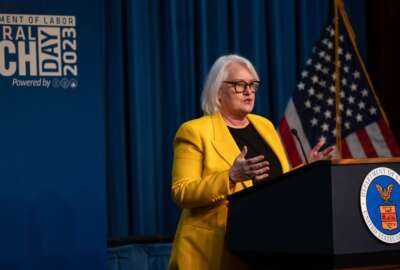Cloud Exchange 2024: CIO Council’s Innovation Committee on making gains through community collaboration
DOE, FDIC and DHS tech leaders of the CIO Council’s Innovation Committee collaborate with agencies on how to think differently about operations and technology.
Earlier this year, Federal Chief Information Officer Clare Martorana challenged the government community to think about this moment in technology differently. She encouraged the federal community to think across the ecosystem and about the “big bets” the public and private sectors are making in technology for the next generation.
Martorana asked: How can agencies harness that energy to think differently, to maximize their opportunities and to be safe, responsible and creative?
She may have thrown the gauntlet down to agencies and industry alike, but the Federal CIO Council’s Innovation Committee is leading the response. We talked with the committee’s three leaders — Ann Dunkin of the Energy Department, Chez Sivagnanam of the Federal Deposit Insurance Corp. and Dave Larrimore of the Homeland Security Department — to learn about the committee’s efforts during Federal News Network’s Cloud Exchange 2024.
“Sometimes when innovation comes up, people easily relate to emerging technologies. But it’s not. It doesn’t have to be emerging technology and all about new ideas,” said Sivagnanam, chief architect at FDIC. “To me, innovation is taking great ideas from people, experimenting and then finding a way to scale and make sure it’s adapted at an enterprise scale. That is really the [innovation] ecosystem.”
The Innovation Committee creates that ecosystem by bringing together not just CIOs, but chief technology officers, chief data officers, chief artificial intelligence officers and other technology managers across government.
Larrimore, CTO at DHS, said because each of these leaders have different roles and responsibilities, the committee has become a forum for members to discuss big picture challenges and opportunities.
Given the many laws, regulations and policies that collectively and individually impact agencies’ technology efforts and missions, Larrimore described the Innovation Committee as “the connective tissue” between numerous teams, councils, committees, organizations and groups.
“We have representatives from far-reaching backgrounds in various departments and agencies that include cyber equities, that include data, that includes IP operations, et cetera,” he said. “Really, our group is designed around the intersection of those various committees and helping to drive efforts that make sense to have a combined approach.”
Federal innovation ideas with potential for tangible outcomes
One forthcoming example of that is a potential project to be submitted to the Technology Modernization Fund for funding. Dunkin, CIO at Energy, said she can’t offer too many details except that the project will be around AI.
But it’s just one example of how the committee is taking on Martorana’s challenge to think differently.
“We are really trying to find opportunities to create tangible outcomes and not just talk. Even when we do these symposiums, our goal has been to have follow-up happen after the symposium,” Dunkin said. “For example, we did that fraud symposium, and then the CFO Council took that, ran with it and did the next activity around that. Our goal is really to make sure whatever we’re doing it gets sticky, that it gets some outcomes and results and not just, ‘Oh, we had a nice chat today.’ ”
Sivagnanam added that how the committee creates community comes in many different forms. Sometimes it’s as symposiums, like the one it sponsored in March around AI and quantum computing. Other times, the committee develops artifacts like roadmaps or journey maps focused on emerging technologies or data-driven innovation, cybersecurity or customer experience.
“We want to be the bridge across all these different people. If there are great things happening on one side and the other side needs help, we create some artifacts and then drive that journey,” Sivagnanam said. “This year our focus is primarily on data-driven innovations and customer experience. We’re also helping our groups on some of the cybersecurity innovation stuff.”
When it comes to innovation, the committee looks at ideas from two perspectives. The first is operational innovation, which Sivagnanam described as taking a hard look at processes that are done repeatedly — but doing so with an “agile mindset where you try to improve it with some new contributions. That is something that happens all the time.”
The second innovation category involves looking at a process or technology from a “radically different” perspective based on new technology, new people, new data or something that changes the lives of the users.
“The mark of innovation for us is really about the ability to continuously modernize. Our ability to look at big problems and solve them in ways to where we continuously are able to innovate is ultimately the measure of success,” Larrimore said. “It’s something that cloud, agile, DevSecOps all give us access to and so when you start applying commercial AI to those three foundational tenants of modernization, you now have an opportunity to start achieving that goal.”
Examples of innovation targeting AI at DHS around
Dunkin added the committee seeks opportunities that meet a couple of criteria, starting first with what’s most valuable to the government as a whole.
“What can the Innovation Committee do that is going to bring the most value to our colleagues, to the government and to the citizens who pay for all this?” she said. “The second thing is, what is the committee going to get excited about doing? We can come up with this great agenda of things that are going to be great taxpayer value, but ultimately this is a volunteer activity and people do this because they want to do it. We have to create things that people are going to get excited about doing.”
Larrimore highlighted two ongoing innovation efforts at DHS that are all about technology but simultaneously have nothing to do with the technology itself.
“DHS identified a real gap around knowledge, skills and abilities around AI — and in the federal workspace. We’ve instituted a one-of-a-kind DHS AI Corps to bring in 50 AI experts. We already have, I think, seven on board as of today. We’re going to have close to 15 by the end of this fiscal year,” he said.
“We’re already starting to gear them up to deploy projects that are supporting the executive order and other administration priorities in the department. It’s just been incredibly exciting as we have received over 5,500 resumes, and we’ve had several hundred interviews. It is incredible to see the caliber of people. Never in my career have I seen the caliber of individuals coming from the private sector, raising their hand and really saying that ‘I want to support a mission.’ ”
The second example also focuses AI. Larrimore said DHS spent the last several months putting together a first-of-its-kind policy around the use of commercial generative AI tools. It also developed training agreements with several companies for “government-friendly terms of service” as well as supervisory guidebooks and other tools.
“We have made this publicly accessible. We have had several conversations at the state and federal levels, and any federal department can use this,” Larrimore said. “A lot of the companies that we built these agreements with have told us, ‘Please share this as much as possible. We want to be able to accommodate other potential customers.’ We get protection on privacy that we don’t get just using what’s out in the marketplace. We get protections around indemnification that we don’t with a lot of these companies, and it solves a real big gap that we’ve had in the cloud space that the department is really starting to realize is a huge benefit for more than just DHS.”
Dunkin, Larrimore and Sivagnanam also warned that while innovation and government might seem like strange bedfellows, agencies have good reasons to be more cautious than the private sector.
Dunkin said there is widespread acknowledgement that the procurement process can lead to frustrations and can slow down innovative efforts.
But, at the same time, Larrimore said he has seen more desire both from government and industry to explore new and different ways to modernize technology and processes. To that end, he encourages people to participate in the committee’s activities.
“The best way to prevent errors is to ask questions and learn — and have a culture of learning. That has been a huge center point around the reason why the Innovation Committee exists. We want to bring around that culture of learning and culture of sharing,” he said. “I’m going to tell folks to come by and lean in. You don’t have to have a CIO sitting on the Innovation Committee. You can send folks who are really interested in innovation and learning about technologies that their department or agency hasn’t had access to yet, to ask questions about how something works and be part of the community. I guarantee you and your department will be better off.”
Discover more articles and videos now on Federal News Network’s Cloud Exchange 2024 event page.
Copyright © 2025 Federal News Network. All rights reserved. This website is not intended for users located within the European Economic Area.
Jason Miller is executive editor of Federal News Network and directs news coverage on the people, policy and programs of the federal government.
Follow @jmillerWFED







